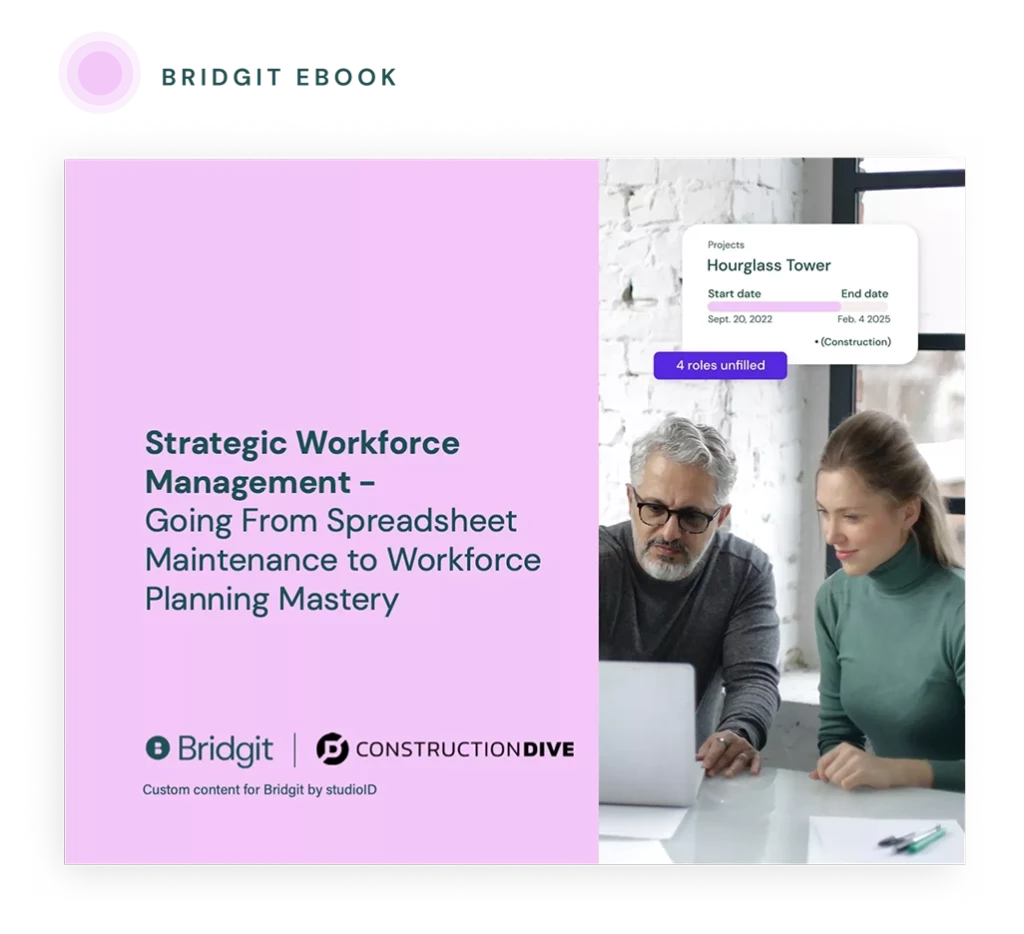Effectively managing the construction labor burden can be the difference between a company’s ultimate success and failure. It’s important to ensure that you’re getting the right number of hours from every employee, that everyone is being paid the correct wage, and that you’re properly tracking all the benefits employees are entitled to.
Table of Contents
Although it can be quite labor-intensive and time-consuming, it’s absolutely essential to get it right. Here’s what you need to know about managing labor burden, the average labor burden rate in construction, and how companies effectively deal with expenses.
What is labor burden in construction?
Labor burden in construction is the total cost of employee compensation and benefits, expressed as a percentage of payroll. It can include salaries, wages, bonuses, commissions, vacation pay, sick pay, health insurance, and pension costs. To turn a profit, construction companies must carefully manage their labor burden and ensure that all employees are paid accordingly.
For example, a construction company employs a project manager with a base salary of $60,000 per year. In addition to the salary, the company contributes $6,000 to the project manager’s health insurance plan, $3,000 in pension contributions, $4,590 in payroll taxes (FICA), and $1,500 for workers’ compensation insurance. In this case, the labor burden amounts to $15,090, or roughly 25% of the project manager’s base salary. Thus, for every $1 the company pays in salary, it incurs an additional $0.25 in labor burden costs.
In indirect costs, the average labor burden rate for construction employees is about 30 to 40%. This means that for every dollar that a construction company pays in employee compensation and benefits, it pays an additional 30 cents in overhead costs. For union contractors, the percentage is usually a bit higher, at 60 to 70%.
Why is managing labor burden important?
Managing labor burden is crucial for many reasons, but one of the most important is its close ties to proper budgeting. Managers can make more informed decisions on hiring and pricing jobs by understanding how much labor constitutes a budget. This essentially helps them optimize costs and avoid construction cost overruns.
Labor burden management also directly affects a company’s bottom line. When workers aren’t paid on time or properly, it lowers morale and can put a business at risk of being sued for unpaid wages.
Therefore, effectively managing labor burden allows construction companies to keep overhead costs down, increase profit margins, and maintain productivity.

Looking to be more strategic with your people?
We partnered with Construction Dive to outline the steps any contractor can take to be more strategic with their workforce management.
How can companies manage the construction labor burden?
Since labor burden can be a significant expense for construction companies, keeping it under control is important. There are several strategies to manage this effectively, each focusing on different aspects of labor costs and operations. Below are some key approaches that construction companies can implement:
- Accurately calculate your labor burden
- Control payroll costs
- Use more contract workers
- Minimize turnover
Accurately calculate your labor burden
Accurate calculations are crucial for understanding the full extent of labor costs. This includes all the components that go into construction labor burden calculations, such as wages, taxes, and benefits. Regular reviews of these numbers help ensure that companies are not overspending in any area, and that they have up-to-date figures for project bidding and budgeting.
Control payroll costs
Monitoring salaries, wages, and bonuses is essential to ensure that you’re only paying for the work completed. By reviewing payroll regularly and staying within budgeted limits, companies can prevent overspending. Payroll management software can also be a valuable tool for tracking hours and ensuring that all labor-related costs are accurately accounted for.
Use more contract workers
Contract workers offer a way to reduce labor costs since they typically don’t receive the same benefits as full-time employees. This can be especially useful for short-term projects or when specialized skills are needed for a specific job. However, it’s important to balance this with the quality and consistency of work, ensuring that contract workers meet the company’s standards.
Minimize turnover
High turnover can lead to significant expenses, including recruitment, training, and lost productivity. It’s important to invest in employee satisfaction and engagement to keep turnover rates low. Offering competitive compensation, providing opportunities for advancement, and fostering a positive work environment are all ways to reduce turnover and retain skilled workers.
How to Calculate Labor Burden for Construction
Calculating labor burden in construction involves accounting for both direct and indirect costs associated with your workforce. Here’s a step-by-step breakdown:
- Direct Labor Costs: These include all wages, salaries, bonuses, and overtime paid to employees for their work on construction projects.
- Indirect Labor Costs: These are the additional costs associated with employing workers, such as health insurance, retirement contributions, paid time off, and other benefits. Indirect costs are usually calculated as a percentage of direct labor costs.
To calculate the Labor Burden Rate, divide the total labor costs by the direct labor costs, then multiply the result by 100 to express it as a percentage. The total labor costs are the sum of both direct and indirect labor costs.
Example:
If a company has direct labor costs of $500,000 and indirect labor costs of $150,000, the total labor costs would be $650,000. To calculate the labor burden rate, you would divide $650,000 by $500,000, then multiply by 100. The result would be a labor burden rate of 130%. This means for every dollar spent on wages, the company incurs an additional $0.30 in labor burden costs.
Average Labor Burden Rate in Construction
Understanding the average labor burden rate is essential for accurate project cost estimation. This rate typically ranges between 30% and 40% for most construction companies. However, if you are managing unionized workers, the rate can be significantly higher—sometimes reaching 60% to 70%—due to additional benefits, union dues, and other associated costs.
Regularly reviewing and updating your labor burden calculations based on these averages ensures that your project budgets remain accurate and reflect all overhead costs.
Tips for conducting a construction labor burden assessment
Conducting a labor burden assessment helps keep these pointers in mind.
Consider implementing technology
Technology, especially ones that streamline administrative tasks and automate calculations, can make managing labor much easier.
Workforce management systems, for example, can be useful tools for optimizing labor. These platforms help you put the right people on the job and avoid over-allocating tasks to employees, which decreases employee turnover and can save your construction firm money.
With construction projects often being large and involving many hands, keeping track of employees can be difficult. Workforce management systems simplify this while decreasing overhead costs, making managing the construction labor burden a breeze.
Time tracking is another helpful technology that can be used to understand how much time is spent on a project, which companies can use to more accurately price their jobs and ensure they’re making a profit.
Although there are a few different ways to track time (including manual time tracking, which involves employees keeping track of their own time and submitting it to their manager at the end of each day), automated time tracking software is more accurate and is the least time-consuming method for employees.
Factor project and external elements into calculations
When conducting a construction labor burden assessment, it’s important to consider the following factors to help estimate construction costs.
- The type of project – The size and scope of the project will impact the amount of labor required and, ultimately, the cost.
- The location of the project – If the project is located in an area with a high cost of living, this can also impact the cost of labor.
- The availability of skilled labor – While the construction industry generally grapples with a skilled labor shortage, some areas suffer worse than others.
- The experience of the workers – More experienced workers will typically command a higher wage than less experienced workers.
- The type of contract – What type of contracts are you offering? Hourly, daily, or lump sum?
- The complexity of the project – A more complex project will require more skilled labor and, as a result, will be more expensive.
- The economy and inflation – The current state of the economy and inflation can also impact the cost of labor.
By considering all of these factors, you can better understand the true cost of labor and then act accordingly.
How often should you review labor burden assessments?
Construction companies should review their construction labor burden assessments regularly. This will help them ensure they’re paying the correct overhead costs and making a profit. Generally, reviewing labor burden assessments at least once per year is advisable.
Manage labor more effectively with Bridgit Bench
The best way to manage labor burden can differ from company to company—what works for one might not work for another, as many construction firms vary in size and scope. Nevertheless, these tips and information, like the average labor burden rate in construction, should give you a good starting point to work off of.
Think your workforce planning meetings could be more productive?
Download our ebook to learn how to run efficient, effective workforce planning meetings with your team.
When contractors need help to oversee construction personnel, many turn to workforce management solutions like Bridgit Bench. Our workforce intelligence platform makes managing labor seamless.
Labor Burden FAQ
What is a fully loaded labor rate?
A fully loaded labor rate includes not just the wages you pay, but also all additional costs like benefits, insurance, and taxes. This figure reflects the total cost of employing someone, providing a comprehensive view of your labor expenses.
How do you calculate fully loaded employee cost?
To calculate the fully loaded employee cost, start with the base salary and add all other expenses associated with that employee, such as benefits, payroll taxes, and insurance. This gives you the true cost of having that employee on your team.
What is the standard labor rate?
The standard labor rate is the base wage paid to workers, excluding additional expenses like benefits or taxes. It varies by job role, industry, and location, but it’s the starting point when calculating labor costs.
How do you accurately estimate construction costs?
Accurately estimating construction costs involves considering both direct and indirect expenses. Direct costs include materials and labor, while indirect costs cover things like permits, equipment, and overhead. Reviewing past project data and creating detailed plans help keep estimates as accurate as possible.



